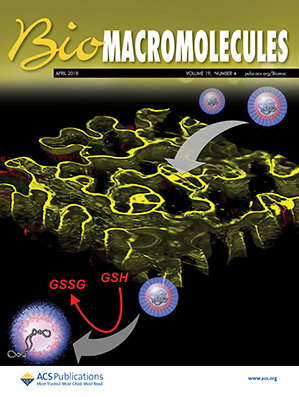High-Performance Triple-Network Hydrogels Derived from Chrome Leather Scraps: Ultrahigh Compressive Strength, Adhesion, and Self-Recovery
IF 5.4
2区 化学
Q1 BIOCHEMISTRY & MOLECULAR BIOLOGY
引用次数: 0
Abstract
The development of engineered hydrogels with high strength, self-recovery, and adhesion is essential for applications requiring resistance to large deformations and cyclic loading. Herein, a triple-network (TN) hydrogel with ultrahigh compressive strength, strong adhesion, and good self-recovery was constructed by using tannic acid-modified chrome leather scrap hydrolysate as the first network, polyacrylamide as the second network, and poly-2-propenamide-2-methylpropanesulfonic acid as the third network. The ultrahigh (70 MPa compressive strength and 95% compression deformation) TN hydrogels were effectively created, which is attributed to the synergy of the three networks. The TN hydrogels display adhesion (adhesion strength > 20 kPa) ascribed to the introduction of phenolic hydroxyl groups in tannic acid. Intriguingly, the TN hydrogels exhibit excellent self-recovery performance (93.6% dissipated energy recovery at 70 °C) and shape memory performance (restored to the original shape in 20 s). These properties are essential for the development of high-performance hydrogels and promote the resource utilization of leather waste.
- Download: Download high-res image (244KB)
- Download: Download full-size image
高性能三网水凝胶源自铬皮革废料:超高抗压强度,附着力和自我恢复。
开发具有高强度、自恢复和粘附性的工程水凝胶对于需要抵抗大变形和循环加载的应用至关重要。以单宁酸修饰的铬皮革废水解液为第一网络,聚丙烯酰胺为第二网络,聚2-丙烯-2-甲基丙磺酸为第三网络,构建了具有超高抗压强度、强附着力、良好自恢复能力的三网络(TN)水凝胶。超高(70 MPa抗压强度和95%压缩变形)的TN水凝胶有效生成,这归功于三个网络的协同作用。由于单宁酸中引入酚羟基,TN水凝胶表现出粘附性(粘附强度> ~ 20kpa)。令人感兴趣的是,TN水凝胶具有优异的自恢复性能(70°C时耗散能量回收率为93.6%)和形状记忆性能(20 s后恢复到原来的形状),这些性能对高性能水凝胶的开发和促进皮革废弃物的资源化利用至关重要。
本文章由计算机程序翻译,如有差异,请以英文原文为准。
求助全文
约1分钟内获得全文
求助全文
来源期刊

Biomacromolecules
化学-高分子科学
CiteScore
10.60
自引率
4.80%
发文量
417
审稿时长
1.6 months
期刊介绍:
Biomacromolecules is a leading forum for the dissemination of cutting-edge research at the interface of polymer science and biology. Submissions to Biomacromolecules should contain strong elements of innovation in terms of macromolecular design, synthesis and characterization, or in the application of polymer materials to biology and medicine.
Topics covered by Biomacromolecules include, but are not exclusively limited to: sustainable polymers, polymers based on natural and renewable resources, degradable polymers, polymer conjugates, polymeric drugs, polymers in biocatalysis, biomacromolecular assembly, biomimetic polymers, polymer-biomineral hybrids, biomimetic-polymer processing, polymer recycling, bioactive polymer surfaces, original polymer design for biomedical applications such as immunotherapy, drug delivery, gene delivery, antimicrobial applications, diagnostic imaging and biosensing, polymers in tissue engineering and regenerative medicine, polymeric scaffolds and hydrogels for cell culture and delivery.
 求助内容:
求助内容: 应助结果提醒方式:
应助结果提醒方式:


